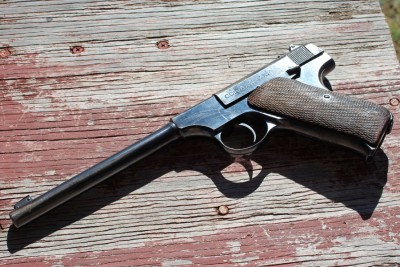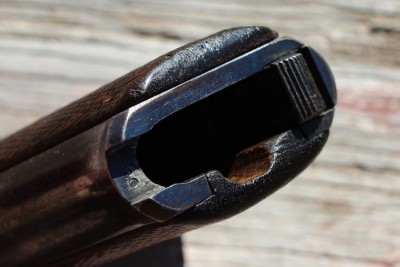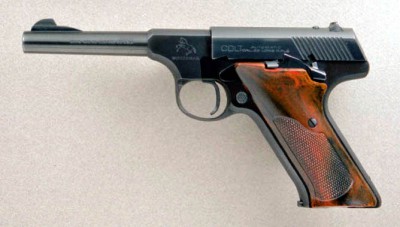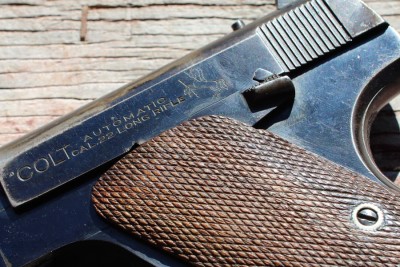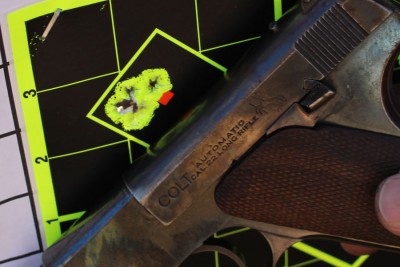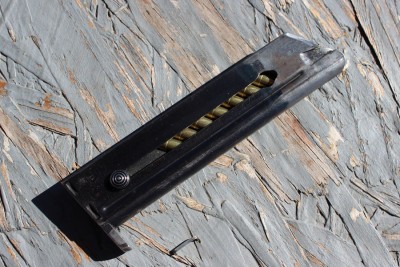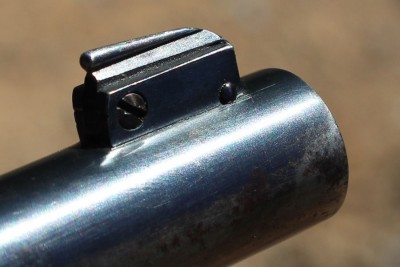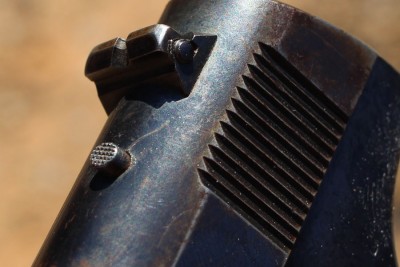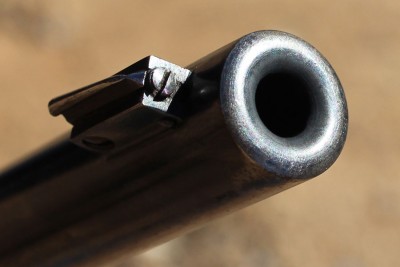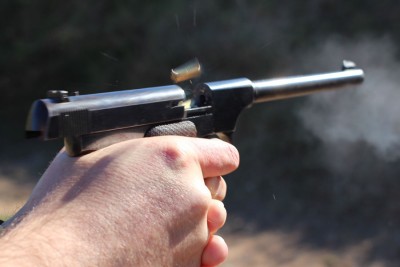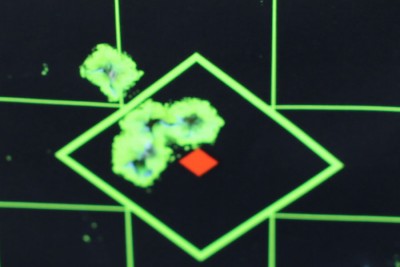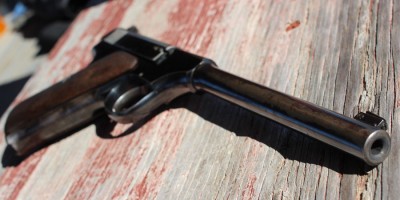It has been awhile but we are back with another installment of Shooting History. This is our series where we take some old guns and… wait for it… shoot them. The idea behind these articles is to give some background and history on the firearms then put them through the tests and evaluations we do with new guns but with lower round counts. If you have missed the other articles in this series you can find them here.
I seem to be on a .22 kick of late. My recent review of the Henry Pump .22 has rekindled my love, and nostalgia, for the little rimfire. So what better way to continue down the .22 road than to review one here. I also have a thing for old Colts–as you well know if you have been following this series. When those two worlds collide, we find a Colt Woodsman.
Design
Like most Colt Automatic Pistols, John Browning had a hand in the design of the Woodsman. I say he had a hand in it because this one was not designed by him alone. It was actually one of his last pistols while working with Colt and other designers finished it out. And it was a great design. The Colt Woodsman was the first reliable .22 self loader on the market and was made from 1915 until 1977.
The design is a very simple one and all of the Woodsmans share the following specs. The woodsman is a fixed barreled pistol with a blow back action. It doesn’t get much simpler than that. The hammer is hidden in the slide where it hits a striker style firing pin. The magazine is a 10 round single stack. Like most guns, and especially old Colts that were made for 60 years, there are a lot of different models and major variants.
Variants
These pistols are called Woodsmans but they didn’t always have that name. “The Woodsman” was first stamped on the side of the frame in 1927. Pistols that were manufactured before then are commonly referred to as a “Pre-Woodsman.” Colt called the first ones the “Colt Automatic Target Pistol.” Overall, there are 3 main different models and 3 different series of the Woodsmans. There isn’t room to get into all of the details but I will outline the high points below. If you want more detailed information Bob Rayburn’s website is pretty much the authority on these Colts. You can find his site here.
There are 3 main different models of the Woodsman. There is the Target Model that has a 6 5/8″ barrel, the Sport Model with a 4.5″ barrel and the heavy barreled Match Target Model that was made in both barrel lengths. These were made over 3 major series changes.
The 1st Series Woodsmans were made from 1915 until 1947. These include the Pre-Woodsman guns and are also called the Pre-WWII models. The 1947 date is used mainly because that is when the 2nd series came out. Production of the Woodsmans all but stopped during and right after the war. During the production of the 1st series small changes were made to the barrel contour and grips. One main feature of the 1st models is the European style magazine release on the heel of the grip.
The 2nd Series were made from 1947 until 1955. The fastest way to tell if the pistol is a 2nd series is if it has a push button magazine release like on a 1911. Only these pistols have this feature. The rear sights also changed to a more user friendly adjustable sight. The 2nd series also saw the introduction of a budget model know as the Challenger which has a C at the end of the serial number. The finish was not as well polished, fixed sights were used and it didn’t have the push button mag release but it was still a 2nd Series pistol. (This can get confusing at times).
The 3rd and final Series was made from 1955 until the end of production in 1977. The magazine release returned to the butt on these. The trigger guard was made bigger and the trigger shape was changed as well. 2nd and 3rd series also have a S suffix added to the serial number. The budget Challenger model was renamed to the Huntsman but kept the C in the serial.
The above is a highly glossed over history of the changes to the Woodsman but should give you a general idea of the pistols evolution.
The Review Gun
The gun used for this article is a Pre-Woodsman target model that was made in 1925. It has front and rear adjustable sights on the 6 5/8″ barrel. The condition of the review gun is pretty good. Yes, a real scientific measurement I know. Functionally it is totally fine but there is a good amount of holster wear to the finish. It is still a solid example of a Pre-Woodsman and has the correct grips and magazine for its date. This gun was purchased from Rock Island Auction Company during an auction. If you haven’t checked out their listings you should, there are some great historic and collectible guns available.
Shooting
Before I shoot any of the guns for the Shooting History Series I always research them to make sure there isn’t some safety concern. Usually everything is fine other than the usual warning against +P ammo. There is one thing on the early Woodsmans that I did come across. It wasn’t until 1933 that these pistols were designed to shoot High Velocity .22 LR. Prior to that date only standard or target ammo can be safely used. The review Woodsman was made in 1925, so no High Velocity for this one. The changes made were to the recoil spring and some of the hardness of the internal parts. Now these are very well made pistols and I wouldn’t expect a good condition Woodsman made before 1933 to fail if you shot SOME of the High Velocity rounds through it. But why would you? First there’s the safety concern, and second–there is no need to abuse an old gun, or any gun, like that.
Equipped with the correct ammo, I ran a bit over 150 rounds through the Woodsman. It ran like a champ. I mostly fired CCI Standard Velocity rounds and a few CCI Green Tags I had available. Both rounds fired and cycled perfectly with no failures. There was also no discernible difference between the two for accuracy. From 25 feet 5 round groups under an inch were the norm. I fired a few strings from 25 yards which opened up to under 5 inches. Those were shot unsupported and I have no doubt the pistol is more capable than the shooter.
The Woodsman was a pleasure to shoot. There is a lot of fun that can be had plinking away with a .22 and the Woodsman makes a great pistol for that purpose. They would also make a great varmint or small game pistol and were originally marketed as such.
Conclusion
The Colt Woodsman, and Pre-Woodsman, is as solid a pistol today as it was in 1915. A good shooting condition Woodsman is a great choice for a .22 pistol. They say imitation is the greatest form of flattery. There have been plenty of Woodsman imitators over the years. Just looking at a High Standard pistol and you can see its roots. Bill Ruger’s first gun is another great example, although he did away with the slide and used a bolt, there is some influence from the Colt there still.
Colt made over 690,000 of the Woodsmans in the various forms. Some are rather common and in good shooting condition can be found for around $500 or a bit lower. However, there are some that are worth a lot. Anything factory engraved from Colt fetches a large premium and there are some Woodsmans that got the fancy treatment. Some of them are just rare. First series Match Target models with original grips are highly sought after as well. Check out what is available on GunsAmerica right now, there are some shooters and some collectible gems.
[one_half]
[/one_half][one_half_last]
[/one_half_last][one_half]
[/one_half][one_half_last]
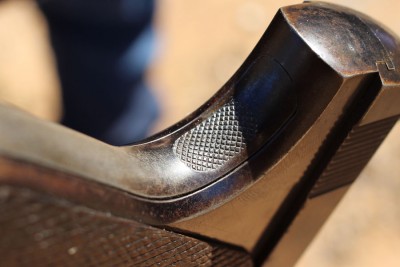
Checkering on the mainspring housing. The shape of the checkering changed when the Woodsman was updated to shoot High Velocity ammo.
[/one_half_last][one_half]
[/one_half][one_half_last]
[/one_half_last][one_half]
[/one_half][one_half_last]
[/one_half_last]
